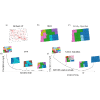Bayesian regionalization of urban mobility networks
引用次数: 0
Abstract
A common method for delineating urban and suburban boundaries is to identify clusters of spatial units that are highly interconnected in a network of mobility flows, each cluster signaling a cohesive economic submarket. It is critical that the methods employed for this task are principled and free of unnecessary tunable parameters to avoid unwanted inductive biases while remaining scalable for high-resolution mobility data. Here, we systematically assess the benefits and limitations of a wide array of stochastic block models (SBMs)—a family of principled, nonparametric models for identifying clusters in networks—for regionalization with mobility data. We find that the data compression capability and relative performance of different SBM variants heavily depend on the spatial extent of the mobility network, its aggregation scale, and the method used for weighting network edges. By constructing a measure to assess the degree to which a network partition violates spatial contiguity, we find that traditional SBMs may produce substantial spatial discontiguities that require extensive postprocessing to make them suitable for regionalization. We propose a fast nonparametric agglomerative algorithm to alleviate this issue, achieving data compression close to that of unconstrained SBM models while ensuring spatial contiguity, benefiting from a deterministic optimization procedure, and being generalizable to wide range of community detection objective functions.

城市交通网络的贝叶斯区域化
划分城市和郊区边界的常用方法是识别在流动网络中高度相互连接的空间单位集群,每个集群代表一个具有凝聚力的经济子市场。至关重要的是,这项任务所采用的方法必须有原则性,并且没有不必要的可调参数,以避免不必要的归纳偏差,同时还能对高分辨率流动数据保持可扩展性。在此,我们系统地评估了各种随机区块模型(SBMs)的优势和局限性--SBMs 是一系列原则性的非参数模型,用于识别网络中的集群,从而利用流动性数据进行区域化。我们发现,不同 SBM 变体的数据压缩能力和相对性能在很大程度上取决于流动性网络的空间范围、其聚合规模以及用于加权网络边缘的方法。通过构建一种评估网络分区违反空间连续性程度的方法,我们发现传统的 SBM 可能会产生严重的空间不连续,需要进行大量的后处理才能使其适用于区域化。我们提出了一种快速的非参数聚类算法来缓解这一问题,在确保空间连续性的同时,实现了接近无约束 SBM 模型的数据压缩,受益于确定性优化程序,并可通用于各种群落检测目标函数。
本文章由计算机程序翻译,如有差异,请以英文原文为准。
求助全文
约1分钟内获得全文
求助全文

 求助内容:
求助内容: 应助结果提醒方式:
应助结果提醒方式:


